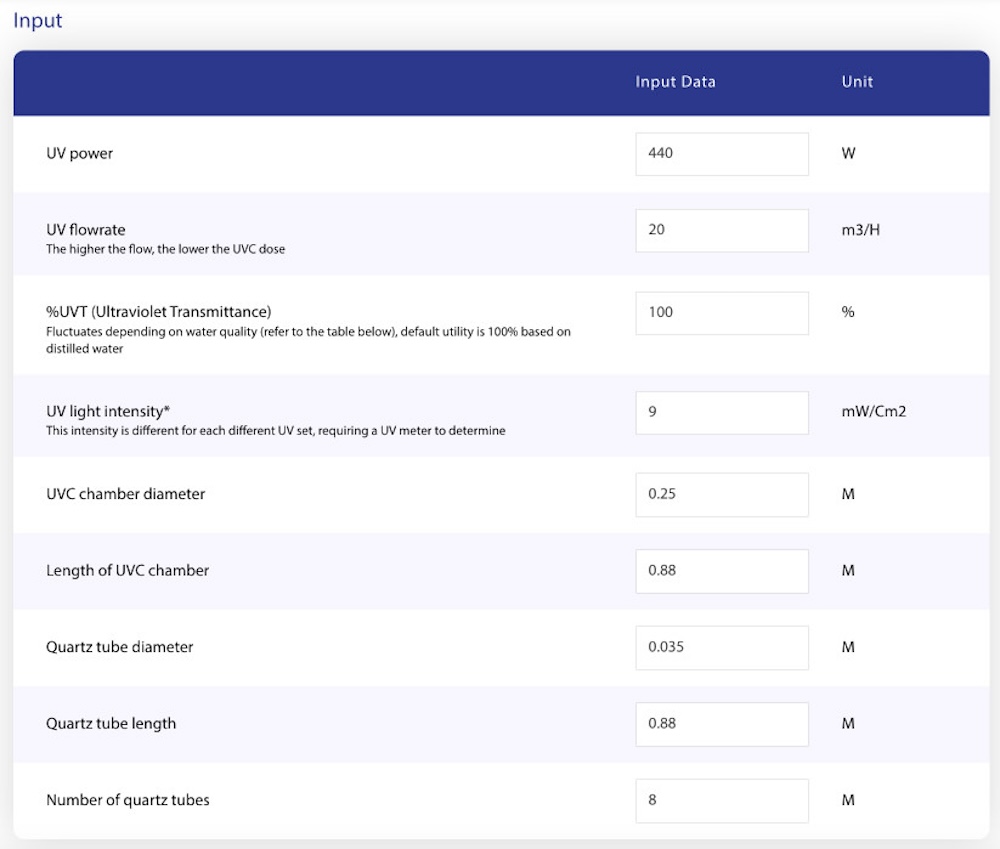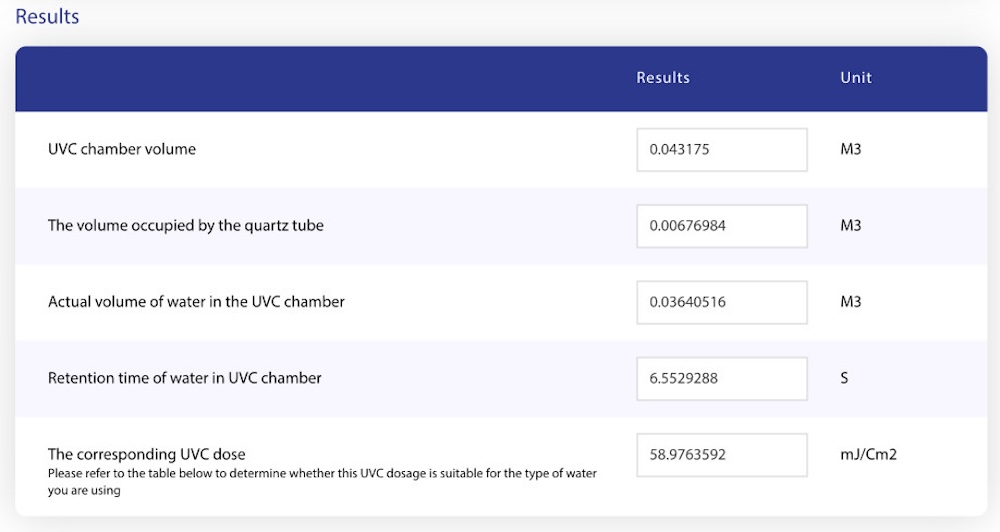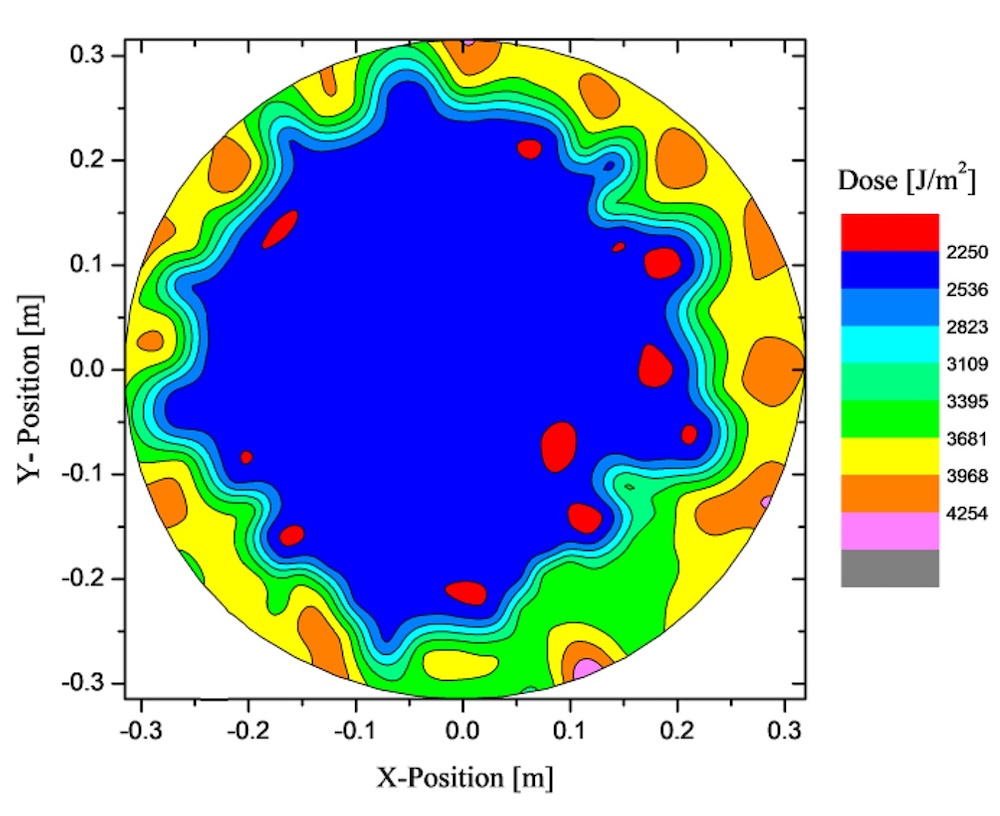Instructions for using the UVC dose calculation utility
Unlike conventional lighting products where we can confirm with the naked eye if it is “bright enough”, UV-C is not visible to the naked eye and this can make it especially difficult from a measurement perspective. In this article, we will explore the basic measurement principles and methods, then look at some examples that help take the necessary steps in determining the irradiance requirements for a particular arrangement.
UVC Dosage = UV Intensity x Time
When designing a UV-C disinfection method, we need to start with the UV-C dose, because the ultimate goal is to achieve a certain UV-C dose needed to inactivate pathogens. But first, what is the correct dosage and how is it measured?
UV-C dose, also known as exposure dose, is a way to measure the total UV-C energy radiated on a particular surface. This is the most important factor in UV-C system design, because the UV-C dose is the main factor that determines whether we will successfully achieve pathogen inactivation.
The dose is determined not only by the intensity of UV-C rays falling on the surface but also the time the surface is exposed to UV-C radiation. In other words, all else equal, a UV-C lamp of half the intensity can achieve the same UV-C dose if it is used for twice as long.
The intensity of UV-C rays falling on a surface is called irradiance and is measured in W/m2 (or some variation of power per surface area). Exposure time is measured in seconds.
The simple form of the formula is shown below:
Dose (mJ/cm2) = (UV intensity (mW/cm2)/%UVT) x Time (seconds)
%UVT is the UV transmittance in water (distilled water is 100%)
Example 1: To produce UV lamps with a dose of 50 mJ/cm2
Suppose you are tasked with designing a UV-C system with a target dose of 50 J/m2. How will we do it?
Luckily, you are not given any further constraints so you can achieve this in a variety of ways.
First we take the above formula
…and see that as long as UV radiation multiplied by time gives us 50 mJ/cm2, we meet the requirements here. For example, 50 mW/cm2 for 1 second, 25 mW/cm2 for 2 seconds, or 1 mW/cm2 for 50 seconds all produce 50 mJ/cm2 and are acceptable to achieve the required dose.
Instructions for using the UVC dose calculation utility with images
Calculation utility interface:
Input
| Input Data | Unit | |
|---|---|---|
| UV power | W | |
|
UV flowrate The higher the flow, the lower the UVC dose |
m3/H | |
| %UVT (Ultraviolet Transmittance) Fluctuates depending on water quality (refer to the table below), default utility is 100% based on distilled water | % | |
| UV light intensity* This intensity is different for each different UV set, requiring a UV meter to determine | mW/Cm2 | |
| UVC chamber diameter | M | |
| Length of UVC chamber | M | |
| Quartz tube diameter | M | |
| Quartz tube length | M | |
| Number of quartz tubes | M |
Results
| Results | Unit | |
|---|---|---|
| UVC chamber volume | M3 | |
| The volume occupied by the quartz tube | M3 | |
| Actual volume of water in the UVC chamber | M3 | |
| Retention time of water in UVC chamber | S | |
| The corresponding UVC dose Please refer to the table below to determine whether this UVC dosage is suitable for the type of water you are using | mJ/Cm2 |
Enter the input value
Step 1: Enter the UV lamp power. For example, select the light set Model: SP6-440WS, enter 440
Step 2: Enter the water flow through the lamp, the unit is m3/h. For example, enter 20m3/h
Step 3: The %UVT frame is the ability to transmit UV rays in water. Refer to the table below to get the data. For example, if you choose distilled water, enter 100
Step 4: Enter the UV intensity: This intensity needs to be determined with a meter for each different light set. For example, with the SP6-440WS lamp model, the intensity is 9mW/cm2
Step 5: Enter the diameter of the UV lamp chamber in m, here we choose 0.25
Step 6: Enter the length of the UV lamp chamber in m, here we enter 0.88m
Step 7: Enter the diameter of the quartz tube containing the UV lamp in m, here we choose 0.035
Step 8: Enter the length of the quartz tube containing the UV lamp in m, here we enter 0.88m
Step 9: Enter the number of quartz tube in the lamp. Here we import 8 tubes
The input value is as shown below:

The following results:
Step 10: The volume of the UV chamber is 0.043175m3
Step 11: The volume occupied by the quartz tube is 0.00676984m3
Step 12: Actual volume of water contained in the UV rays: 0.03640516m3
Step 13: Water retention time in the UV chamber: 6.5529288 seconds
Step 14: UVC dose is 58.9763592 mJ/cm2
Then the result will be as follows:

After you have the UVC dosage, you need to look up the following table to see if the type of water you are using has enough UV dosage to kill bacteria:
| Typical Application/ Loại nước | Typical UVT %/ % UVT (độ truyền tia cực tím trong nước) | Normal Required Dose/ Liều lượng UV cần thiết |
|---|---|---|
| Drinking Water/ Nước uống | 90% - 95% | 25 mJ/cm2 RED - 40 mJ/cm2 RED |
| Wastewater/ Nước thải | 50% - 80% | 30 mJ/cm2 Wall Dose |
| Swimming Pools/ Nước hồ bơi | 94% | 60 mJ/cm2 Average |
| Aquaculture/ Nuôi trồng thuỷ sản | 85% - 90% | 320 mJ/cm2 Average |
| Rain Water Harvesting - Irrigation/ Thu nước mưa - Tưới tiêu/Thuỷ lợi | 80% - 85% | 150 mJ/cm2 Wall Dose |
| Rain Water Harvesting - Filter Process/ Thu hoạch nước mưa - Đã được lọc trong | 80% - 85% | 30 mJ/cm2 Wall Dose |
| Process Water - Towns Main/ Xử lý nước thị trấn | 90% | 30 mJ/cm2 |
| Cooling Loops/ Vòng làm mát | 70% - 90% | 30 mJ/cm2 |
| Water after advanced treatment (membranes, reverse osmosis)/ Nước RO | 90% | 25-60 mJ/cm2 |
| Ground water/ Nước ngầm | 85% | 25-40 mJ/cm2 |
| Surface water/ Nước mặt | 85% | 25-40 mJ/cm2 |
| Sea water/Nước biển | 70-90% |
If you have questions about how to calculate UVC dosage, please contact our Company’s Sales department for more detailed instructions.


